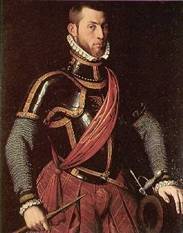
Vespasiano I Gonzaga
Encyclopedia

Sabbioneta
Sabbioneta is a town and comune in the province of Mantua, Lombardy region, northern Italy. It is situated about 30 km north of Parma, not far from the northern bank of the Po River...
, a town in Lombardy designed according to the Renaissance principles of the "Ideal City".
He was born in Fondi
Fondi
Fondi is a city and comune in the province of Latina, Lazio, central Italy, halfway between Rome and Naples. Before the construction of the highway between the latter cities in the late 1950s, Fondi had been an important settlement on the Roman Via Appia, which was the main connection from Rome to...
, a Colonna fief in the southern Latium
Latium
Lazio is one of the 20 administrative regions of Italy, situated in the central peninsular section of the country. With about 5.7 million residents and a GDP of more than 170 billion euros, Lazio is the third most populated and the second richest region of Italy...
, the son of Isabella Colonna and the condottiero Luigi Gonzaga, a member of a cadet branch of the House of Gonzaga
House of Gonzaga
The Gonzaga family ruled Mantua in Northern Italy from 1328 to 1708.-History:In 1433, Gianfrancesco I assumed the title of Marquis of Mantua, and in 1530 Federico II received the title of Duke of Mantua. In 1531, the family acquired the Duchy of Monferrato through marriage...
, Dukes of Mantua
Mantua
Mantua is a city and comune in Lombardy, Italy and capital of the province of the same name. Mantua's historic power and influence under the Gonzaga family, made it one of the main artistic, cultural and notably musical hubs of Northern Italy and the country as a whole...
. Soon orphaned, he was educated under his aunt Giulia Gonzaga
Giulia Gonzaga
Giulia Gonzaga was an Italian noblewoman of the Renaissance.-Biography:Giulia was born in Gazzuolo in 1512. In 1526 she was married to count Vespasiano Colonna , count of Fondi and duke of Traetto...
, who had moved to Naples to escape attempts from other members of the Colonna family to kill Vespasiano in order to obtain the fiefs he had inherited from his mother.

Philip II of Spain
Philip II was King of Spain, Portugal, Naples, Sicily, and, while married to Mary I, King of England and Ireland. He was lord of the Seventeen Provinces from 1556 until 1581, holding various titles for the individual territories such as duke or count....
. The latter found in Vespasiano one of his most faithful advisors, and made him a Great of Spain and then viceroy of Navarre
Navarre
Navarre , officially the Chartered Community of Navarre is an autonomous community in northern Spain, bordering the Basque Country, La Rioja, and Aragon in Spain and Aquitaine in France...
and Valencia
Kingdom of Valencia
The Kingdom of Valencia , located in the eastern shore of the Iberian Peninsula, was one of the component realms of the Crown of Aragon. When the Crown of Aragon merged by dynastic union with the Crown of Castile to form the Kingdom of Spain, the Kingdom of Valencia became a component realm of the...
.
In 1556 he started his major project, the construction of a new, ideal city between Mantua and Parma
Parma
Parma is a city in the Italian region of Emilia-Romagna famous for its ham, its cheese, its architecture and the fine countryside around it. This is the home of the University of Parma, one of the oldest universities in the world....
which he christened "Sabbioneta" ("Sandy"), as it was to rise on the sandy banks of the Po River
Po River
The Po |Ligurian]]: Bodincus or Bodencus) is a river that flows either or – considering the length of the Maira, a right bank tributary – eastward across northern Italy, from a spring seeping from a stony hillside at Pian del Re, a flat place at the head of the Val Po under the northwest face...
. The project was finished in 1591. Sabbioneta had been declared an autonomous Duchy in 1577, thanks to the personal support of Vespasiano's friend Rudolf II of Habsburg, whom he had met in the Spanish court.
He died at Sabbioneta in 1591.

